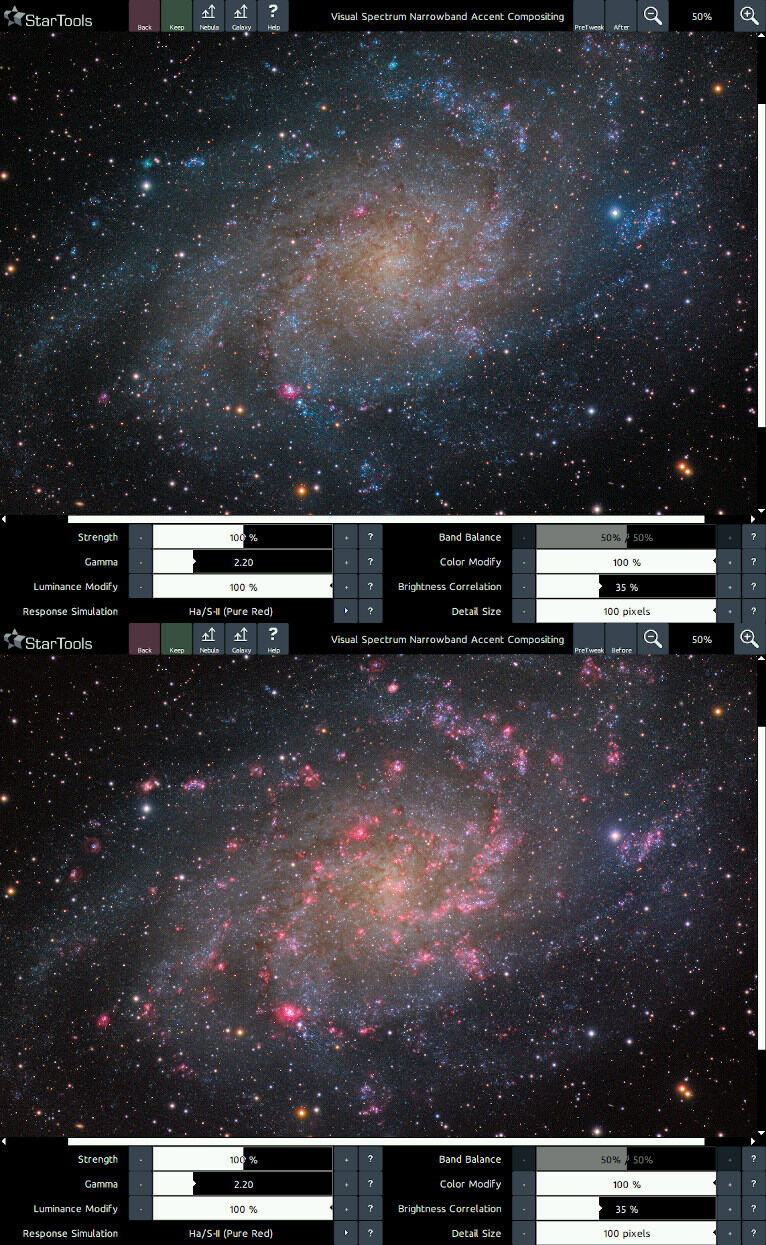- Usage
- Stage 2: Accentuating your image with narrowband accents
Stage 2: Accentuating your image with narrowband accents

The second stage is all about using the signal from the first stage in a manner you find aesthetically pleasing.
Straight up, there are two presets that are useful in two of the NBAccent's major use cases;
- 'Nebula'; to accentuate detail associated with Milkyway nebulosity
- 'Galaxy'; to accentuate smaller detail in other galaxies
These presets dial in the most useful settings for these two usecases.
The 'Response Simulation' parameter is responsible for the visual spectrum coloring equivalent that is synthesised from the narrowband data. The NBAccent module was designed to synthesise plausible visual spectrum coloring for a wide range of scenarios and filters;
- Ha/S-II (Pure Red); uses the narrowband data's red channel to add pure, deep red accents to the image. While pure red is rather rare in visual spectrum images (due to these emissions almost never existing by themselves and instead being accompanied by other emissions that are much bluer), it can nevertheless be useful to make these areas stand out very well.
- HII/Balmer Series (Red/Purple); uses the narrowband data's red channel to add the familiar red/purple colour of HII areas to the image. This mode makes the assumption that the other visual spectrum emissions from the Balmer series (almost all blue) are also present where the H-alpha line was detected. This mode tends to yield renditions that matches closely with the colouring of HII areas in actual visual spectrum data.
- Hb/O-III (Cyan); uses the narrowband data's green and blue channels to add pure cyan accents, corresponding to the colour of areas of strong Hb/O-III emissions as powered by nearby O or B-class blue giant stars.
- O-III (Teal); uses the narrowband data's green and blue channels to add teal green accents, corresponding to the colour of areas of strong O-III emissions
- Ha/S-II (Pure Red) + Hb/O-III (Cyan); uses pure deep red accents for data from the red channel, while using cyan accents for data from the blue and green channels. This mode is particularly useful for narrowband data acquired through the popular duo/tri/quadband filters.
- Ha/S-II (Pure Red) + O-III (Teal); uses pure deep red accents for data from the red channel, while using teal green accents for data from the blue and green channels. This mode is particularly useful for narrowband data acquired through the popular duo/tri/quadband filters.
- HII/Balmer Series (Red/Purple) + Hb/O-III (Cyan); synthesises the full Balmer series (red/purple) from the red channel, while using cyan accents for data from the blue and green channels. This mode is particularly useful for narrowband data acquired through the popular duo/tri/quadband filters.
- HII/Balmer Series (Red/Purple) + O-III (Teal); synthesises the full Balmer series (red/purple) from the red channel, while using green accents for data from the blue and green channels. This mode is particularly useful for narrowband data acquired through the popular duo/tri/quadband filters.
The 'Luminance Modify' and 'Color Modify' parameters, precisely control how much the module is allowed to modify of the visual spectrum image's luminance/detail and colour respectively. For example, by setting 'Luminance Modify' to 0%, and leaving 'Color Modify' at 100%, only the colouring will be modified, but the narrowband accent data will not (perceptually) influence the brightness of any pixels of the final image. Conversely, by setting 'Color Modify' to 0% and 'Luminance Modify' to 100%, the narrowband accent data will significantly brighten the image in areas of strong narrowband emissions, however the colouring will remain (perceptually) the same as the visual spectrum input image.
You may also be interested in...
- Why does StarTools keep throwing "Could not create Tracking data files" popups? (under Technical FAQ)
As such StarTools uses your storage memory (hard drive or SSD drive) to store this data.
- SVDecon: Detail Recovery through Spatially Variant Distortion Correction (under Features & Documentation)
The fully GPU accelerated solution is robust in the face of even severe noise, meaning it can deployed to restore detail in almost real-time in almost every dataset.
- Log (under Introduction)
StarTools keeps a detailed log of what modules and parameters you used.
- Video (under Quick Start)
Please refer to the video description below the video for the source data and other helpful links.
- Tracking (under Introduction)
Signal evolution Tracking data mining plays a very important role in StarTools and understanding it is key to achieving superior results with StarTools.
